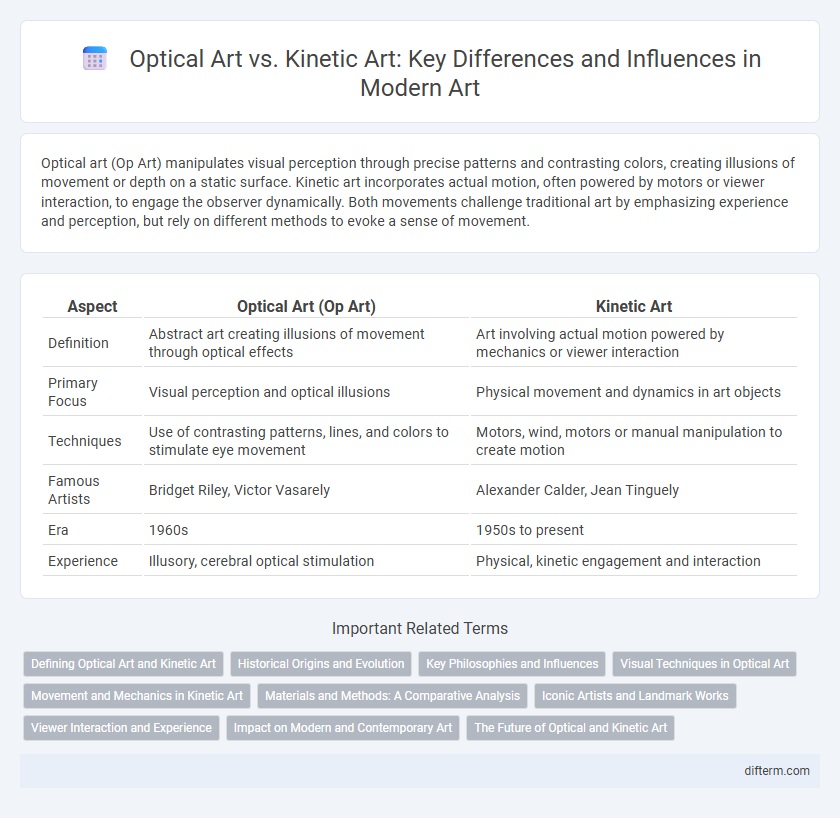Optical art (Op Art) manipulates visual perception through precise patterns and contrasting colors, creating illusions of movement or depth on a static surface. Kinetic art incorporates actual motion, often powered by motors or viewer interaction, to engage the observer dynamically. Both movements challenge traditional art by emphasizing experience and perception, but rely on different methods to evoke a sense of movement.
Table of Comparison
| Aspect | Optical Art (Op Art) | Kinetic Art |
|---|---|---|
| Definition | Abstract art creating illusions of movement through optical effects | Art involving actual motion powered by mechanics or viewer interaction |
| Primary Focus | Visual perception and optical illusions | Physical movement and dynamics in art objects |
| Techniques | Use of contrasting patterns, lines, and colors to stimulate eye movement | Motors, wind, motors or manual manipulation to create motion |
| Famous Artists | Bridget Riley, Victor Vasarely | Alexander Calder, Jean Tinguely |
| Era | 1960s | 1950s to present |
| Experience | Illusory, cerebral optical stimulation | Physical, kinetic engagement and interaction |
Defining Optical Art and Kinetic Art
Optical art (Op Art) utilizes precise patterns, contrasting colors, and geometric shapes to create visual illusions that trick the viewer's perception of movement and depth on a static surface. Kinetic art involves actual physical movement or the illusion of movement through mechanisms, light, or interaction, making the artwork dynamic and ever-changing. Both art forms explore motion, but optical art emphasizes perceptual effects while kinetic art incorporates real motion.
Historical Origins and Evolution
Optical art, emerging prominently in the 1960s through artists like Bridget Riley and Victor Vasarely, focuses on creating visual illusions and manipulating perception using geometric patterns and contrasting colors. Kinetic art, with roots tracing back to the early 20th century and artists such as Alexander Calder and Naum Gabo, incorporates actual movement or the illusion of motion, blending sculpture with mechanical or natural energy sources. Both movements evolved as responses to modernism, exploring new dimensions of viewer interaction and visual experience in the realm of contemporary art.
Key Philosophies and Influences
Optical art (Op Art) emphasizes visual perception and the illusion of movement through precise patterns and contrasting colors, rooted in Gestalt psychology and the study of optical phenomena. Kinetic art centers on actual motion, incorporating mechanical components or viewer interaction, inspired by Constructivism and Futurism's fascination with technology and dynamism. Both movements challenge traditional static art by engaging viewers through sensory experience and shifting perspectives.
Visual Techniques in Optical Art
Optical Art employs precise geometric patterns, high-contrast colors, and repetitive shapes to create visual illusions of movement and depth, engaging the viewer's perception. Techniques such as moire effects, color vibration, and figure-ground ambiguity manipulate light and space on a two-dimensional surface. Unlike Kinetic Art, which relies on actual physical motion, Optical Art generates dynamic effects purely through visual stimuli.
Movement and Mechanics in Kinetic Art
Kinetic art emphasizes actual physical movement through motors, gears, and mechanical components, creating dynamic artworks that change over time. Optical art relies on visual illusions and the manipulation of static patterns to evoke a sense of motion without physical movement. The integration of mechanics in kinetic art allows viewers to experience art as a temporal event, contrasting with the perceptual effects central to optical art.
Materials and Methods: A Comparative Analysis
Optical art primarily employs flat, two-dimensional materials such as paint and canvas to create visual effects that stimulate the viewer's perception through precise geometric patterns and contrasting colors. In contrast, kinetic art incorporates three-dimensional materials like metal, plastic, and motors, utilizing mechanical movement or natural forces to produce dynamic visual experiences. The methods of optical art rely on optical illusions and static surfaces, whereas kinetic art emphasizes physical motion and viewer interaction through engineered or natural kinetic mechanisms.
Iconic Artists and Landmark Works
Optical art, championed by artists like Bridget Riley and Victor Vasarely, emphasizes visual perception through geometric patterns and color contrasts, as seen in Riley's "Movement in Squares" and Vasarely's "Zebra." Kinetic art, represented by figures such as Alexander Calder and Jean Tinguely, incorporates movement and mechanical elements, exemplified by Calder's mobiles and Tinguely's self-destructive sculptures. These landmark works highlight the contrast between optical illusion and physical motion in modern art.
Viewer Interaction and Experience
Optical art engages viewers through static visual effects, creating illusions of movement and depth that challenge perception and invite closer examination. Kinetic art incorporates actual motion, often powered by motors or viewer interaction, providing a dynamic sensory experience that evolves in real time. Both forms prioritize active viewer participation, with optical art manipulating visual perception and kinetic art offering physical interaction to deepen engagement.
Impact on Modern and Contemporary Art
Optical art revolutionized modern aesthetics by manipulating visual perception through patterns and color contrasts, influencing graphic design and digital media. Kinetic art introduced movement into artworks, challenging traditional static forms and inspiring interactive installations in contemporary galleries. Together, these movements expanded the boundaries of artistic experience, integrating technology and viewer engagement into modern and contemporary art practices.
The Future of Optical and Kinetic Art
Optical art (Op Art) and kinetic art continue evolving through integration with digital technology and interactive media, enhancing viewer immersion and sensory engagement. Advances in augmented reality and motion sensors propel kinetic sculptures beyond physical movement, creating dynamic, responsive experiences that challenge perception. The future of these art forms hinges on blending traditional optical illusions with new technological capabilities, expanding their impact in contemporary visual culture.
optical art vs kinetic art Infographic

 difterm.com
difterm.com